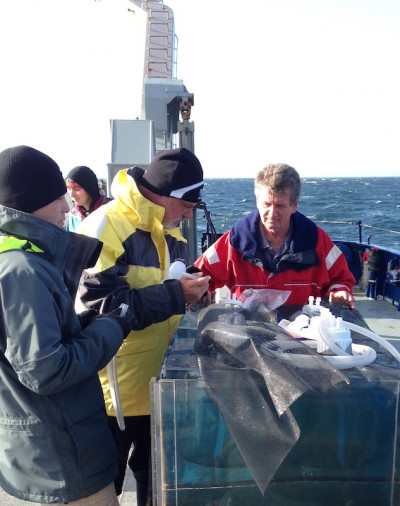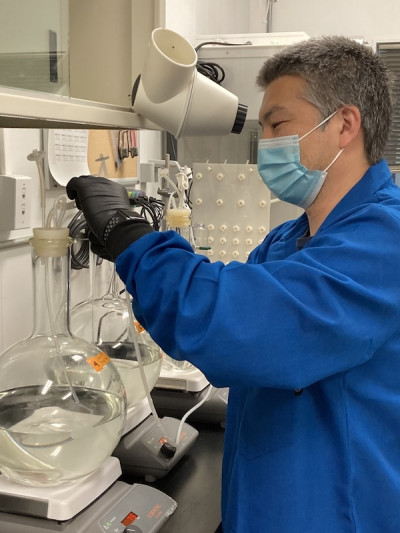This is the fifth in a yearlong series of stories showcasing the research that the Ocean Protection Council supported in partnership with California Sea Grant, with funding from Proposition 84.
Header image: Pseudo-nitzschia australis isolated during the massive 2015 toxic diatom bloom along the U.S. West Coast. Credit: Charles Wingert, Cochlan Phytoplankton Ecophysiology Laboratory, SFSU
Albert Hitchcock’s film The Birds is famous for its idiosyncratic source of terror: several species of birds begin to attack the people living in a coastal village in California. And while the film is fictional, it was inspired by a real-world phenomenon. In November 1961, “crazed seabirds pelted the shores of North Monterey Bay, California,” as one newspaper put it at the time.
We know today that local marine phytoplankton produced the neurotoxin known as domoic acid, which the birds consumed, precipitating the attack. At the time, though, the event was a mystery. Much of the modern science on domoic acid — and on Pseudo-nitzschia, the single-celled marine alga that produces it — commenced after hundreds of people in eastern Canada fell ill in 1987 after consuming contaminated blue mussels. Three people died. The outbreak underlined the potential threat to both ecosystems and public health, as the toxin worked its way up the marine food chain.

The California Department of Public Health launched a monitoring program in 1991, testing edible shellfish tissue for domoic acid — an effort to ensure no similar crisis struck the state. Monitoring remains the primary strategy for protecting the public from amnesic shellfish poisoning (ASP), a disease caused by ingesting tainted planktivorous fish or shellfish. The program noted domoic acid in Dungeness crab in 2015, for example, during a massive bloom of Pseudo-nitzschia in 2015, which impacted the crabbing season, a major economic blow. These monitoring programs have helped ensure that there have been no further recorded human deaths and minimal illnesses in humans. In the future, though, monitoring alone may prove insufficient. The frequency and magnitude of Pseudo-nitzschia blooms — and, more importantly, the amount of domoic acid they produce — appears to be increasing globally, and there is little reason to expect the trend to stop. Warmer waters and greater acidity, the evil oceanic twins of climate change, have both been pegged as potential drivers for increased domoic acid production.
There are already models available that forecast potential toxic blooms, but these are based on statistical correlations, rather than direct biological and physiological knowledge. In other words, we’re just watching for environmental conditions similar to those that coincided with earlier outbreaks, rather than specifying conditions shown to trigger domoic acid production.
“It’s like the stock market,” says Raphael Kundela, a professor of ocean sciences at the University of California Santa Cruz who helps build these models. “Past performance does not always correlate with future outcomes.” This is especially true as climate change alters ecosystems. “We much, much prefer to have a model based on biology,” Kundela says.
In 2018, using funds administered by California Sea Grant and authorized by Proposition 84, William Cochlan, a senior research scientist at the Estuary & Ocean Science Center, San Francisco State University, launched a multi-year laboratory project focused on Pseudo-nitzschia, and what environmental factors enhanced the growth of these algal cells and their production of domoic acid.

To ensure their data would be as valuable as possible, Cochlan used freshly isolated strains of Pseudo-nitzschia from Monterey Bay, which has remained a domoic acid hotspot in the decades since the 1961 bird attacks. His research team focused on species of Pseudo-nitzschia that had proven most problematic in previous blooms. And unlike earlier domoic acid studies, where these microalgae were allowed to grow continuously, Cochlan’s controlled experimental studies tried to closely mimic the conditions off California’s coastline. One key factor that prompts the growth of these cells and the formation of blooms is the upwelling of deep, nutrient-rich waters. Since such upwelling events are episodic, driven by prevailing winds, Cochlan’s team cycled through both nutrient-sufficient and -deficient conditions, just as such cells would experience in nature.
Cochlan was careful to study how environmental stressors impact not just the growth of these algal cells, but whether these stressors affect how much domoic acid each cell produces — two different responses that, if not carefully observed, can become blurred and scientifically misinterpreted. Cochlan’s team also determined whether the domoic was found as a particulate domoic acid, which is found within algal cells, or as fully dissolved domoic acid that’s been released from the cells into the water itself. This was critical since up to now, only the particulate phase was thought to be directly transferable up the marine food chain and thus increase the toxic threat to marine ecosystems.
Cochlan also studied the intertwined effects of light and temperature, which are expected to respond to climate change, potentially influencing the production of domoic acid. But it was the results of the trials on ocean acidification that were the most striking.

“They were obvious. Crystal clear. And they were not what we expected,” Cochlan says. “We found that increased ocean acidity (as measured by reduced pH values) did not increase domoic acid production rate and did not increase cellular growth rate. This is contrary to what I’ve seen with another species we’ve tested and is in contrast with earlier studies performed by others.”
To Cochlan, these unexpected results offer a reminder that researchers need to be cautious about generalizations. For the toxigenic diatom species most relevant to California, ocean acidification may not be a major concern compared to the increasingly warmer sea surface temperature resulting from climate change. Cochlan’s team also found that these environmental stressors should not be just studied independently, but need to be examined in combination. Cochlan, who retired from San Francisco State University in 2023, recently received funding from the National Oceanic and Atmospheric Administration for a larger-scale study, a collaborative project with researchers from the Northwest Indian College, the University of Washington, NOAA’s Pacific Marine Environmental Lab (PMEL) and Washington Sea Grant. The new project will examine whether the same findings hold true in the Pacific Northwest, where ocean acidification is more widespread and of greater intensity than in California. Cochlan’s team will be providing its data to several modelers to improve researchers’ ability to forecast domoic acid-producing blooms under a variety of climate change scenarios, and many of their results have already been presented to the scientific community at both international and national scientific conferences.